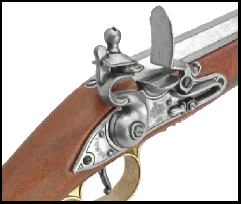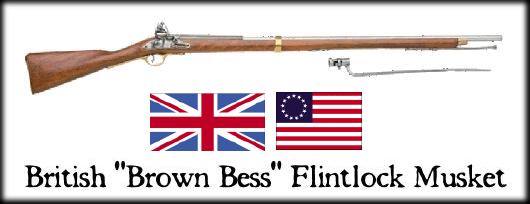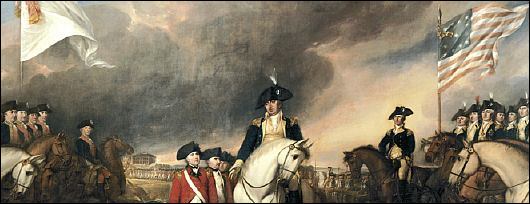Brown Bess Musket. First in a Long Line of Great British Military Small Arms that Made History.

The American War of Independence (aka the Revolutionary War) was the one of the first conflicts where flintlock muskets were heavily used, overtaking hand-to-hand combat with sabers as the primary method of doing battle. In the 18th and 19th Centuries, when the ranks of soldiers closed in on their enemies, they did battle with bayonets, a strong throwback to previous centuries. Of course, bayonets were still in use well into World War II, at least as a secondary weapon or a last resort. Even after the advent of firearms, using the great ancient contribution to world warfare (and pyrotechnical amusement) of the Chinese, gunpowder. At the time, it was made with charcoal, (hickory is usually considered best, if available) sulphur and saltpeter (the nitrate part of the equation) which when packed or compressed, was highly explosive. The alchemical ingredient for warfare and mayhem that played a major part in shaping world history.
There is some uncertainty over where the name "Brown Bess" originates from, but the most likely origin is the German term "Braun Buss" meaning "strong gun" Since the weapon was commissioned during the reign of King George I, a native of what is now Germany, this does seem to be a very plausible origin for the name. Furthermore, at that time German musket design was effective and successful, and being copied by nearly everyone in Europe, including the British. The name "Brown Bess" was not officially used, but was a popular nickname among soldiers who were "married to Bess" or "hugging Bess," slang terms for being a soldier. The "Brown Bess" flintlock musket was made famous, if for no other reason, than that it was used by soldiers on both sides of the Revolutionary War. The official weapon of the British Infantry, it was also exported to the Colonies long before they rebelled against the crown, resulting in the British fighting against a force that had many of its militants using the same weapons. There were also a large number of French Charleville muskets used by the colonists and the Continental Army, having been given as a gift by LaFayette to General George Washington. Others were bought from the French, who at the time were in an on-and-off state of war with Britain, as they had been since medieval times. The Charleville had a slightly smaller ball, but was lighter and more slender.
The Brown Bess was also one of the first weapons to utilize standardization of size and caliber, employing a template, or "pattern", making it easier to supply troops with ammunition that would fit in their weapons. Prior to the use of patterns, the wide range of assorted weapons, each using a different different wildcat caliber of ammunition, made for a supply nightmare in the field. This was no insignificant development, as it greatly aided in the future of warfare that is still standardized. Before this time, many guards and volunteers would show up with their own muskets, in a variety of calibers. There were many different patterns made throughout the lifespan of the Brown Bess. The patterns most commonly associated with the American War of Independence, were the Brown Bess "New Pattern" and "Land Pattern" muskets. The Land Pattern smoothbore musket was 62.5 inches (159 cm) long and weighed about 15 pounds (6.8 Kg) with the bayonet attached, and fired a lead ball that measured a whopping 3/4ths of an inch (1.9 cm) in diameter! Imagine what kind of damage such a projectile could do, especially compared to our modern weapons. I shudder to think of the suffering inflicted upon any person being hit by one of these things.

As mentioned in my other posts, combat tactics were considerably different in those days. Many people today look with curiosity upon rows of soldiers marching towards each other, while firing at each other, though I admit, I certainly wouldn't want to do this. It may seem like certain suicide to be advancing in the front row with .69" or .75" lead balls flying at you with deadly force. What many probably fail to realize is that in the 18th Century, since soldiers were not in radio contact with their battalion and regiment commanders, they had to be within vocal range in order to receive voice commands to fire, advance or retreat. Lacking the benefit of self-contained cartridges and repeating firearms. they had to learn to reload their muskets in a hurry. It has been said that with practice, a good soldier could get off 3 rounds in a minute. A lot of it was in the timing as well, the idea being to always have a mass of infantrymen with their muskets loaded, ready to fire a synchronized volley to decimate their advancing enemies as much as possible before they closed range, and went at it with bayonets. Since the primary use of the musket ran to volleys of massed firepower, accuracy was not as important as it with today's rifles. Also, a smoothbore generally doesn't allow for accuracy beyond 60 to 100 yards.
The Brown Bess musket was designed in 1722, and saw us e clear up until about the mid 1800s. There were modifications made during the 19th century, most notably the "Pattern 1839" co n version from the original flintlock mechanism to percussion caps, resulting in more reliable firing in wet conditions. In addition to the "Land Pattern, there were the New Pattern, Marine Pattern, Sea Service or Navy Pattern, India Pattern and others.
In addition to the American War of Independence, the Brown Bess also saw use in the War of 1812, the Indian Wars, the British Zulu wars, the Napoleonic Wars, and even the Texas Revolution, where General Santa Anna's army marched on the Alamo, the Battle of San Jacinto and other battles, armed with India Pattern Brown Bess Muskets. The Brown Bess is now a treasured collectors item that fetches high prices at auction. Many have exchanged or retooled furniture, which is not surprising being as how some of them are almost 300 years old. Definitely a worthy item of historical significance.

Firearm Type:
Flintlock Musket
Nation Of Manufacture: Britain
Military Service Dates : 1722-1860
Variations: Land Pattern, Sea Service
Pattern, Marine Pattern,many more variations
Ammunition: .75" (1.9cm) Lead Ball
Wars: Napoleonic Wars, American War of
Independence, Texas Revolution, more
Recent Prices at Auction for Originals: US
$600-$4,000
Interested in an authentic replica Brown Bess Flintlock Musket?